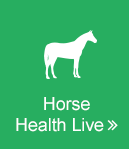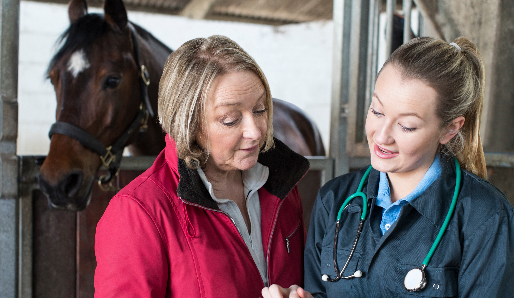Vaccinations for horses protect them from dangerous and often deadly diseases. Vaccines introduce a small amount of dead or weakened bacteria or virus (antigen) into the horse’s body. Doing this teaches the body to produce antibodies against that disease. Then, if the horse comes in contact with that specific antigen again, it is prepared to fight it off.
Vaccinating gives horses a better chance of not coming down with the disease at all, having a milder and shorter version of it, or at least not having to be hospitalized or risk death. Vaccines also save owners money in the long run by reducing medical bills. Finally, vaccines keep horses performing, whether that means racing, showing, breeding, or giving the grandkids lead line lessons.
Veterinarians categorize vaccinations for horses in two ways. “Core” vaccines are the ones every horse should get every year. “Risk-based” vaccines are for diseases specific to a certain region or population of horses.
Core Vaccinations for Horses:
Eastern/Western Equine Encephalomyelitis (EEE/WEE)
Encephalomyelitis means inflammation (-itis) of the brain (-encephalo) and spinal cord (-myelo). EEE and WEE are viruses spread by mosquitoes and other biting insects. EEE and WEE are not contagious and therefore cannot be spread from one horse to another.
If a horse contracts EEE, they develop a high fever, depression, and lose their appetite. In two to three days, neurologic signs appear and include weakness, incoordination, periods of drowsiness and excitement, tremors, convulsions, and paralysis. The prognosis is poor – 75 to 95% of horses with EEE do not survive.
The signs of WEE are nearly the same as EEE. Specific testing must be done by a veterinarian to make a diagnosis. The prognosis for WEE is fair, with roughly 20 to 40% of horses being euthanized or passing away. Some of those that make it are left with long-term problems.
There is no treatment for either disease so prevention by vaccination is key.
West Nile Virus (WNV)
West Nile Virus is another form of encephalomyelitis also spread by mosquitoes and other biting insects. It is not contagious and therefore cannot be passed from one horse to another. However, humans and other animals can come down with WNV from being bitten by an infected insect, just like horses.
Signs of West Nile Virus are similar to EEE/WEE. They include fever, depression, and loss of appetite. As the disease progresses, the horse will also show the same types of neurological problems. Up to 40% of infected horses die from the disease or are euthanized if they go down and are unable to stand. There is no cure, only prevention by vaccination.
Tetanus
The bacteria that causes “lockjaw” is commonly associated with a rusty, old nail but actually lives in the intestinal tract of horses and other animals. It is therefore found in high numbers in feces/manure and soil. It commonly enters the body through puncture wounds (especially of the hoof), cuts and lacerations, surgery, and the umbilicus of foals.
Classic signs of tetanus in horses are a sawhorse stance due to muscle stiffness and spasms in the legs, and an inability to open and close the mouth because of muscle spasms in the head and neck. Even with treatment, 80% of horses will die from a tetanus infection, which is easily preventable with an annual vaccine.
Rabies
Rabies is a virus that can be transmitted to any mammal, including humans. The virus usually enters the body with the bite of an infected animal. It can also enter through open wounds or mucous membranes like the eyes, nose, and mouth.
The incubation period is long (two to six weeks). Clinical signs can look like many other diseases and conditions such as lameness, colic, infection, neurologic disease, etc. There is no treatment for rabies in horses. It is always fatal, and it can be passed to humans. Annual vaccination is highly recommended by both veterinarians and public health officials.
Risk-based Vaccines for Horses:
Equine Influenza
The virus that causes “flu” in horses is spread through the air and through contact with contaminated objects such as stalls, feed and water buckets, grooming equipment, etc. Signs include a dry cough, high fever, nasal discharge, depression, loss of appetite, and stiff, sore muscles. There is no specific treatment, but most horses recover in a few weeks. Sometimes recovery can take as long as six months.
Equine Rhinopneumonitis
Both Equine Herpesvirus-1 (EHV-1) and Equine Herpesvirus-4 (EHV-4) are causes of the mild respiratory disease “rhino,” and abortion in pregnant mares. Both can also develop into the neurologic form of herpesvirus, which causes outbreaks every year in places where horses co-mingle, such as shows and racetracks. Infected horses can become silent carriers for the rest of their lives, shedding virus during times of stress.
Strangles
The bacteria that causes Strangles (Strep. equi) is spread by direct contact with an infected horse, as well as through contact with contaminated objects such as stalls, feed and water buckets, grooming equipment, etc. In addition to fever, nasal discharge, and cough, the classic sign of Strangles is abscesses in the throatlatch area that drain thick, yellow mucus.
Botulism
Horses develop this bacterial disease either by eating or drinking contaminated food or water, or from a wound getting contaminated. Without treatment, 100% of horses will die from a botulism infection. Even with treatment, most horses do not survive. However, the sooner treatment is begun the better the chances. Recognizing the classic signs of a limp paralysis, severe muscle weakness, and inability to swallow is critical to survival.
Potomac Horse Fever (PHF)
The risk of horses coming down with this bacterial disease is higher if they live within five miles or so of a stream, river, or irrigated pasture in certain parts of the country. Horses contract the bacteria by ingesting aquatic insects infected with it. In addition to a very high fever, horses with PHF may break with diarrhea. Laminitis, colic, and swelling of the limbs are also common signs.
There are specific and different vaccination protocols for each of these diseases for pregnant mares, foals, and adult horses. Owners should not only talk to their veterinarian about when and what vaccines their horse should get, but also have that veterinarian administer the vaccines. This ensures the product is safely handled, safely given, and likely backed by a guarantee from the vaccine manufacturer. Vaccinations for horses


